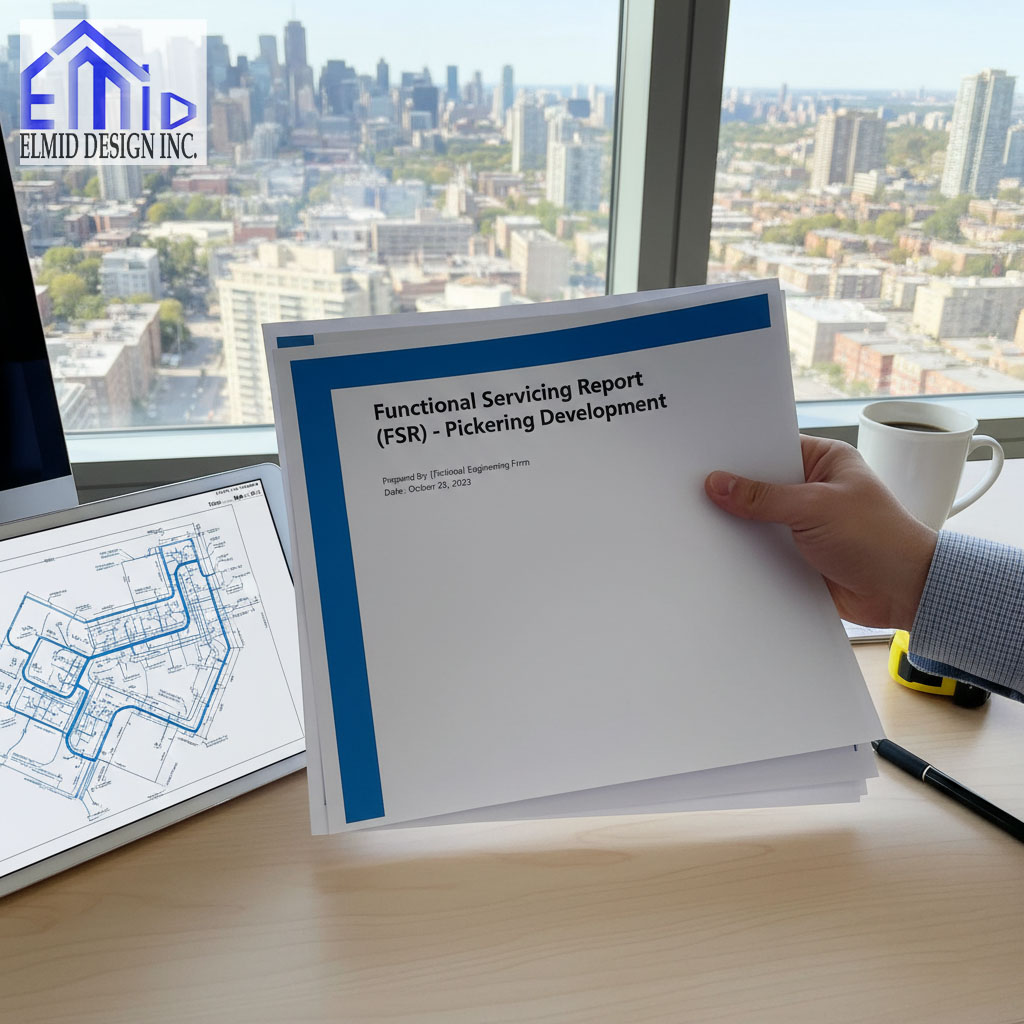A Functional Servicing Report Pickering is one of the most critical documents required for development applications within the City of Pickering. It defines how proposed projects will connect to and impact the municipal infrastructure system. Developers, engineers, and planners rely on this report to demonstrate that their site can be efficiently and safely serviced. Understanding how this report works, what it includes, and why it matters for projects in Pickering is essential for anyone involved in land development.
Key Takeaways
A Functional Servicing Report Pickering explains how a site will be serviced by water, wastewater, and stormwater systems.
It ensures the proposed development meets municipal standards and environmental regulations.
Professional engineering input, such as from Elmid Design Inc with a PEO certificate of authorization, guarantees compliance and technical accuracy.
What is a Functional Servicing Report
A Functional Servicing Report is an essential engineering document that supports planning applications by clearly describing the servicing strategies for new developments. It not only outlines how the proposed land use will connect to water, sanitary, and stormwater systems but also explains how these systems will function together efficiently. Moreover, the report verifies that sufficient capacity exists in municipal infrastructure; otherwise, it proposes upgrades where necessary to ensure reliability. In Pickering, this report aligns with municipal standards, Durham Region design criteria, and conservation authority requirements. Consequently, it provides technical proof that a project can proceed safely while maintaining environmental integrity. Ultimately, this ensures that developments move forward without overloading existing systems or creating unnecessary environmental risks, thereby supporting sustainable urban growth across the community.
Why Pickering Has a Unique Context
Pickering’s terrain, environmental features, and regulatory framework together create a complex environment for servicing design. The city not only includes areas within the Oak Ridges Moraine but also contains sensitive wetlands and older infrastructure systems that therefore require careful planning. Consequently, each project must balance development needs with environmental protection as well as sustainable stormwater practices. Moreover, the municipality works closely with conservation authorities to maintain watercourse stability and, at the same time, minimize downstream impacts. As a result, developers preparing a Functional Servicing Report Pickering must demonstrate that all these local factors have been properly understood, thoroughly assessed, and fully integrated into the design process to ensure responsible and compliant development.
Components of a Functional Servicing Report Pickering
A Functional Servicing Report in Pickering includes several key components that together form the foundation of any development submission. To begin with, the introduction defines the project location, scope, and purpose, allowing reviewers to understand the overall intent. Next, the existing conditions section carefully outlines topography, drainage, and available infrastructure so that engineers can identify design constraints early. Furthermore, proposed servicing plans for water, sanitary, and stormwater systems follow in logical order. Each section then presents calculations, design drawings, and modeling results that demonstrate compliance with municipal and provincial standards. Finally, the report concludes with clear engineering recommendations that support approvals. Elmid Design Inc consistently provides this level of technical support, ensuring that every submission not only satisfies review authorities but also progresses efficiently through the planning process from start to finish.
Site Conditions and Constraints
Before designing servicing systems, engineers must assess existing site conditions. In Pickering, the terrain varies from flat urban zones to rolling rural lands that drain toward Lake Ontario. Understanding soil permeability, groundwater levels, and drainage patterns is vital for accurate modeling. Constraints such as wetlands, floodplains, and existing utilities shape how services are routed and sized. A Functional Servicing Report Pickering includes mapping and survey data that define these physical limits. Elmid Design Inc integrates this information early in design to prevent costly redesigns and maintain compliance with environmental requirements.
Water Servicing Design
Water servicing ensures a reliable supply for both domestic use and fire protection. In Pickering, water design therefore follows Region of Durham standards for pressure, flow, and network capacity. Additionally, the Functional Servicing Report Pickering outlines projected demands based on land use and population equivalents, which helps engineers evaluate future system performance. Moreover, hydraulic modeling confirms that adequate flow and pressure are consistently maintained throughout the network. In cases where municipal watermains are unavailable, on-site systems or main extensions may be proposed as practical alternatives. Consequently, the design considers peak demand conditions, fire flow requirements, and potential looping for greater reliability. Ultimately, qualified engineers prepare these calculations carefully to support municipal approval and to ensure long-term serviceability across the entire development area.
Sanitary Servicing Design
Sanitary servicing manages wastewater collection and disposal for new developments, ensuring systems remain efficient and safe. The Functional Servicing Report Pickering therefore defines how sanitary flows are generated, routed, and connected to the municipal sewer network. Furthermore, flow rates depend on both land use and occupancy, while capacity analysis confirms that existing systems can accommodate the additional load. In situations where municipal services are not yet available, septic systems or temporary holding tanks may be introduced until full connections become possible. Consequently, proper sanitary design prevents overflows, contamination, and infrastructure strain. In addition, clear long-term planning helps maintain environmental protection and operational efficiency. Ultimately, Elmid Design Inc’s engineering expertise ensures full compliance with regional and environmental standards while supporting sustainable community development across Pickering.
Stormwater Management Approach
Stormwater management is a cornerstone of every Functional Servicing Report Pickering. It addresses water quantity, quality, and erosion control. The design must replicate pre-development flow conditions and mitigate downstream flooding. Engineers evaluate multiple design storms and use hydrologic models to predict system performance. Quality treatment involves oil and grit separators, sediment forebays, and vegetated swales. Pickering encourages low-impact development techniques to promote infiltration and reduce runoff. Each design must meet provincial stormwater management guidelines and conservation authority targets for peak flow reduction and water quality improvement.
Grading and Drainage Design
Grading design establishes how surface runoff moves safely across the site. In Pickering, grading plans maintain existing drainage patterns and protect neighboring properties from flooding. Slopes, elevations, and overland flow routes are shown on detailed drawings. A Functional Servicing Report Pickering explains how grading integrates with the stormwater system to provide both major and minor flow paths. Drainage systems use catch basins, pipes, and swales to direct water to approved outlets. The design also includes erosion and sediment control during construction, preventing environmental degradation and ensuring regulatory compliance.
Modeling and Technical Analysis
Every Functional Servicing Report Pickering relies on analytical tools to confirm design performance. Software such as Visual OTTHYMO or XPSWMM models rainfall, runoff, and hydraulic behavior under multiple scenarios. Engineers input topographic and land use data to simulate pre- and post-development conditions. The results demonstrate whether the proposed design maintains flow control, capacity, and environmental safety. Sensitivity testing and calibration improve reliability. These models provide decision-makers with the technical assurance needed for approval and construction. Experienced consultants like Elmid Design Inc deliver these modeling studies with precise documentation and professional accountability.
Best Practices for Pickering Projects
Developing in Pickering requires proactive communication with municipal staff and conservation authorities. Early consultation ensures that design parameters, such as allowable release rates and servicing standards, are clear. Successful Functional Servicing Report Pickering submissions emphasize transparency, detailed modeling, and compliance with policy documents. Avoiding assumptions, using verified data, and coordinating with other engineering disciplines prevent design conflicts. Developers should engage professional engineers early to ensure that technical requirements are met and approvals progress efficiently. A thorough and accurate report saves time, reduces costs, and improves community acceptance.
Role of Elmid Design Inc
Elmid Design Inc provides professional engineering services with a certificate of authorization from Professional Engineers Ontario. The firm prepares detailed Functional Servicing Report Pickering submissions for residential, commercial, and industrial developments. Their approach emphasizes technical precision, compliance with regional standards, and collaboration with municipal reviewers. With experience in stormwater management, sanitary systems, and water distribution, Elmid Design Inc ensures that each project advances efficiently from concept to approval. The firm’s reputation for quality and integrity aligns with the professional standards expected under PEO regulations.

Sanitary Servicing Design in Detail
Sanitary servicing within a Functional Servicing Report Pickering confirms that wastewater from a site will be safely conveyed and treated. Engineers calculate sanitary flows based on population density and land use, ensuring downstream systems have adequate capacity. In some cases, available sewers may not have sufficient depth or size, requiring lift stations or design revisions. In rural Pickering, temporary septic systems are sometimes necessary until municipal services are extended. Detailed drawings illustrate pipe routes, slopes, and maintenance access. The design ensures proper alignment with gravity flow and compliance with regional standards for wastewater collection and treatment.
Coordination with Durham Region Standards
Durham Region manages many of Pickering’s primary water and sanitary systems. The Functional Servicing Report Pickering must demonstrate that each proposed service meets the Region’s hydraulic and environmental guidelines. Capacity checks verify that trunk mains and treatment facilities can handle projected flows. Engineers coordinate directly with regional staff to confirm system availability, upgrade requirements, or alternative solutions. Proper coordination ensures consistent service reliability across the city. When Elmid Design Inc prepares these reports, every design aligns with Durham’s engineering standards and municipal expectations for long-term infrastructure resilience.
Stormwater Quantity Control
Stormwater quantity control is essential to prevent flooding and protect downstream systems. In Pickering, a Functional Servicing Report must demonstrate that post-development flows do not exceed pre-development rates for all critical storms. Engineers simulate runoff volumes using hydrologic modeling tools, adjusting pond sizes, outlet structures, and orifice controls to meet targets. Detention facilities such as dry ponds or underground storage may be required depending on available space. This approach ensures that urban expansion in Pickering remains hydrologically neutral and sustainable while preserving the safety of surrounding properties and infrastructure.
Stormwater Quality Control
Water quality protection complements quantity control. A Functional Servicing Report Pickering includes strategies that remove suspended solids, hydrocarbons, and other pollutants before discharge. Oil and grit separators, vegetated swales, and filter systems are integrated within the stormwater network. Engineers evaluate pollutant removal efficiency and confirm compliance with provincial guidelines. In environmentally sensitive areas near wetlands or tributaries, enhanced treatment systems and low-impact development measures are used. Maintaining water quality supports Pickering’s environmental stewardship goals and demonstrates adherence to the region’s stormwater management hierarchy.
Erosion and Sediment Control
Construction activities can destabilize soils and introduce sediment into receiving waters. Therefore, a Functional Servicing Report Pickering includes temporary erosion and sediment control plans. Measures such as silt fences, stabilized construction entrances, and sediment traps are detailed in both text and drawings. These controls remain active throughout construction until permanent vegetation or paving stabilizes exposed surfaces. By implementing these measures, engineers reduce sediment transport, maintain water clarity, and protect local ecosystems. Continuous monitoring during construction ensures compliance with municipal environmental standards and minimizes long-term maintenance issues.
Grading and Drainage Integration
Grading design connects the surface environment to the subsurface infrastructure described in the Functional Servicing Report Pickering. The grading plan manages surface runoff while preserving existing drainage boundaries. Engineers model elevations to create continuous slopes toward catch basins or swales, preventing ponding and erosion. Overland flow routes accommodate extreme storm events beyond the system’s design capacity. Integration between grading and stormwater management ensures consistent flow control across the site. This coordination forms a vital link between planning, construction, and long-term functionality of municipal infrastructure.
Hydraulic and Hydrologic Modeling
Modeling validates every engineering assumption in a Functional Servicing Report Pickering. Hydrologic models simulate rainfall-runoff processes to assess flow rates and volumes, while hydraulic models evaluate pipe capacity and head losses. These tools help engineers refine pond dimensions, pipe diameters, and orifice openings. By testing multiple storm scenarios, the design ensures resilience during rare but critical weather events. Sensitivity analysis identifies potential risks and supports adaptive design. Elmid Design Inc applies these modeling methods to verify that each proposed system achieves the required level of service and environmental protection.
Review and Approval Process
A Functional Servicing Report Pickering undergoes multiple levels of review before acceptance. Municipal engineers, conservation authorities, and regional departments evaluate hydraulic consistency, environmental impact, and regulatory compliance. Comments often require revisions to improve documentation or clarify design intent. Effective communication between the proponent and the reviewing agencies accelerates the approval timeline. Elmid Design Inc’s experience with municipal submissions ensures efficient navigation through this process. A well-prepared report minimizes review cycles, reduces project delays, and strengthens confidence in the proposed infrastructure.
Best Practices for Functional Servicing Reports
Successful Functional Servicing Report Pickering submissions demonstrate clarity, accuracy, and collaboration. Engineers begin with verified data, clear assumptions, and consistent formatting. Early engagement with city staff defines expectations for modeling, infrastructure connection points, and design criteria. Each section should logically connect to the next, ensuring that readers can follow calculations and results without confusion. Avoiding redundancy and maintaining concise language improves readability and transparency. Comprehensive quality control checks confirm that figures, drawings, and appendices align perfectly with the written analysis, creating a complete and dependable submission.
Common Design Challenges
Projects in Pickering face challenges such as limited existing capacity, environmental constraints, and topographic variations. A Functional Servicing Report Pickering addresses these issues through innovative engineering solutions. When sewer or water systems are unavailable, temporary measures must still meet safety and environmental standards. Managing runoff from steep slopes or sensitive catchments requires tailored designs that maintain flow stability. Each challenge reinforces the need for professional oversight and precise calculations. By addressing potential issues early, developers reduce construction risk and maintain compliance throughout the project lifecycle.
Sustainable and Low Impact Design
Modern Functional Servicing Report Pickering documents incorporate sustainability through low-impact development techniques. These methods reduce runoff, promote infiltration, and enhance groundwater recharge. Practices such as permeable pavements, bioswales, and green roofs integrate with traditional infrastructure to achieve better environmental outcomes. These designs not only meet stormwater management objectives but also support Pickering’s sustainability goals. Elmid Design Inc applies sustainable engineering strategies that extend system longevity and improve urban resilience against climate variability. Sustainable servicing represents the future of responsible development within the city.
Advanced Hydraulic Design Considerations
Advanced hydraulic design in a Functional Servicing Report Pickering ensures that infrastructure performs efficiently under all loading conditions. Engineers use detailed computer simulations to predict flow velocity, pressure fluctuations, and energy losses. These models account for seasonal changes and long-term demand growth. Designs include redundancy within the water and sewer networks to maintain service continuity during maintenance or emergency conditions. Each model validation improves reliability and reduces uncertainty in future infrastructure expansions. Elmid Design Inc applies these detailed analyses to confirm that all design parameters meet municipal and regional requirements.
Integration with Environmental Policies
Pickering’s location within the Greater Toronto Area introduces unique environmental policies that directly influence a Functional Servicing Report Pickering. The Oak Ridges Moraine Conservation Plan, Greenbelt Plan, and local watershed management guidelines establish clear limits on land disturbance and water discharge. Engineers integrate these policies into their analysis to ensure that every proposed system supports sustainable development. Reports must demonstrate that natural hydrology remains intact and ecological integrity is preserved. This alignment between engineering design and environmental stewardship strengthens municipal confidence and ensures long-term project viability.
Climate Change and Resilient Infrastructure
Modern Functional Servicing Report Pickering documents now include resilience planning to address climate change. Increased rainfall intensity and unpredictable weather patterns demand adaptable infrastructure. Engineers simulate future climate scenarios and assess the ability of stormwater systems to manage larger runoff volumes. Designs often include additional storage, enhanced outlet controls, or overflow routing to manage extreme conditions. Incorporating resilience reduces maintenance costs and enhances community safety. Elmid Design Inc integrates climate-responsive design features that exceed minimum standards and support Pickering’s long-term sustainability goals.
Digital Modeling and Data Integration
Technology plays a major role in improving the quality of a Functional Servicing Report Pickering. Digital modeling platforms link topographic surveys, geographic information systems, and hydraulic models into a unified dataset. This integration allows engineers to visualize infrastructure performance in real time and identify potential design conflicts before construction. Advanced software tools also enable precise documentation and streamlined updates during municipal reviews. Digital collaboration improves accuracy, transparency, and efficiency at every stage of development. Elmid Design Inc’s adoption of digital engineering tools ensures accuracy and innovation in every submission.
Municipal Collaboration and Stakeholder Engagement
A Functional Servicing Report Pickering benefits from early and continuous collaboration with municipal departments, regional engineers, and conservation authorities. Open communication ensures alignment between the project objectives and regulatory expectations. Stakeholders provide valuable feedback that helps refine design assumptions and prevent review delays. Transparent engagement demonstrates professional integrity and builds trust with municipal reviewers. Elmid Design Inc maintains strong relationships with local authorities through consistent communication and accurate reporting, ensuring smoother project approvals and reduced risk of rework.
Engineering Documentation and Quality Assurance
Quality assurance is a cornerstone of a professional Functional Servicing Report Pickering. Each report undergoes technical review by qualified engineers before submission. This process ensures that calculations, figures, and design notes are internally consistent and fully supported. Proper documentation allows reviewers to trace every assumption, method, and result within the report. Adherence to recognized engineering standards enhances credibility and reliability. Elmid Design Inc enforces strict internal review procedures that meet the professional expectations set by Professional Engineers Ontario, ensuring every report reflects technical accuracy and ethical responsibility.
Importance of PEO Authorization
Professional Engineers Ontario grants certificates of authorization to engineering firms that meet regulatory and ethical standards. A Functional Servicing Report Pickering prepared under a PEO-authorized firm guarantees accountability and technical competence. This certification ensures that every analysis, drawing, and recommendation carries the oversight of a licensed professional engineer. Clients and municipalities rely on this authorization as proof of professional credibility. Elmid Design Inc’s certification demonstrates compliance with PEO’s regulatory framework, providing confidence that all work meets provincial engineering and safety standards.
Future Trends in Functional Servicing Design
The future of Functional Servicing Report Pickering preparation will emphasize sustainability, automation, and integrated urban design. The increasing use of artificial intelligence and remote sensing technologies will enhance data collection and analysis accuracy. Smart infrastructure monitoring will allow municipalities to track system performance in real time, enabling predictive maintenance. Engineers will also integrate renewable energy systems and green infrastructure to reduce environmental impact. As Pickering continues to grow, functional servicing will evolve toward a data-driven, sustainable, and community-centered discipline supported by professional engineering expertise.
Continuous Professional Development
Maintaining excellence in preparing a Functional Servicing Report Pickering requires ongoing learning. Engineers must stay updated on new design standards, modeling tools, and environmental legislation. Continuous professional development ensures accurate and relevant reporting. Participation in seminars, municipal workshops, and professional training enhances the quality of submissions and reduces design errors. Elmid Design Inc invests in professional education to maintain its reputation for accuracy and innovation within Ontario’s engineering community. A culture of learning ensures that clients receive reports built on current knowledge and best practices.
Long-Term Impact on Pickering’s Growth
A comprehensive Functional Servicing Report Pickering influences how the city expands. Each approved report shapes infrastructure networks that will serve future generations. By ensuring proper servicing and environmental balance, these reports guide sustainable land development. The outcome is a city that grows responsibly while maintaining natural and structural integrity. With contributions from engineering firms like Elmid Design Inc, Pickering continues to achieve balanced progress that supports economic growth without compromising environmental health or infrastructure reliability.
Role of Elmid Design Inc in Pickering Projects
Elmid Design Inc continues to support development across Pickering by preparing comprehensive and compliant Functional Servicing Report Pickering submissions. With a certificate of authorization from Professional Engineers Ontario, the firm combines regulatory knowledge with practical design experience. Each report produced by Elmid Design Inc demonstrates technical excellence and adherence to municipal standards. Their professional guidance simplifies the approval process and strengthens confidence among stakeholders. By ensuring precise engineering and consistent documentation, the company contributes to Pickering’s responsible growth and infrastructure sustainability.
Frequently Asked Questions
What is a Functional Servicing Report Pickering
A Functional Servicing Report Pickering is a technical document that outlines how a development connects to municipal systems, including water, sanitary, and stormwater services. It ensures that infrastructure can handle additional demand while meeting city standards and environmental regulations.
When is a Functional Servicing Report required in Pickering
This report is required whenever a new development, subdivision, or site plan application proposes changes to municipal servicing. It demonstrates that all utilities and drainage systems can operate safely once the project is built.
Who prepares a Functional Servicing Report
Only licensed professional engineers prepare Functional Servicing Reports. Firms such as Elmid Design Inc, which hold a certificate of authorization from Professional Engineers Ontario, provide the technical expertise and accountability needed for municipal approval.
What information does the report include
A Functional Servicing Report includes site descriptions, servicing strategies, hydraulic modeling, stormwater management plans, grading details, and calculations that verify design capacity. It forms the basis for engineering approvals and construction design.
Why choose a PEO-certified firm for this work
PEO-certified firms meet strict professional standards that ensure quality and integrity. Choosing such a firm guarantees that the Functional Servicing Report Pickering complies with all municipal, regional, and environmental requirements, protecting both clients and the public interest.

Elmid Design Inc: Trusted Engineering Experts in Pickering
Elmid Design Inc is a Professional Engineers Ontario licensed firm that provides expert civil and municipal engineering services across Ontario. Specializing in Functional Servicing Report Pickering preparation, the company delivers accurate, regulation-compliant designs that support sustainable development. With a PEO Certificate of Authorization, Elmid Design Inc ensures every project meets the highest engineering and safety standards. The firm’s commitment to precision, transparency, and environmental responsibility has made it a trusted partner for developers, municipalities, and private clients seeking dependable engineering solutions in Pickering and beyond.
Geographic Locations That We Service:
Our Licensed Professional Engineers specializing in Engineered Site Grading Plans offer the best-engineered site grading plan, lot grading and erosion plan, and drainage plan to obtain site plan approval and building permits in Ontario, including a wide range of municipalities. Each area boasts unique features and requirements, making our tailored approach essential for success.
Toronto and Surrounding Areas
In the vibrant heart of Ontario, we service Toronto (City of Toronto) and surrounding areas. Additionally, we cover Oshawa (City of Oshawa), Pickering (City of Pickering), and Clarington (Municipality of Clarington). Furthermore, our expertise extends to Ajax (Town of Ajax), Whitby (Town of Whitby), Brock (Township of Brock), Scugog (Township of Scugog), and Uxbridge (Township of Uxbridge).
Halton Region
Moving to the Halton Region, our services encompass Burlington (City of Burlington) and Halton Hills (Town of Halton Hills). Also included are Milton (Town of Milton) and Oakville (Town of Oakville).
Peel Region
In the Peel Region, we provide services in Brampton (City of Brampton), Mississauga (City of Mississauga), and Caledon (Town of Caledon).
York Region
Our services in the York Region cover Vaughan (City of Vaughan), Aurora (Town of Aurora), and East Gwillimbury (Town of East Gwillimbury). We also cater to Georgina (Town of Georgina), Markham (City of Markham), Newmarket (Town of Newmarket), Richmond Hill (City of Richmond Hill), Whitchurch-Stouffville (Town of Whitchurch-Stouffville), King (Township of King), and Bradford-West Gwillimbury (Town of Bradford-West Gwillimbury). Each municipality here offers a distinct setting, requiring our specialized approach.
Other Southern Ontario Cities and Towns
We also serve many other cities and towns in Southern Ontario. These include Hamilton (City of Hamilton), St. Catharines (City of St. Catharines), Niagara on the Lake (Town of Niagara on the Lake), Brant (County of Brant), Cambridge (City of Cambridge), Kitchener (City of Kitchener), Waterloo (City of Waterloo), and Woodstock (City of Woodstock). Furthermore, we operate in Guelph (City of Guelph), Centre Wellington (Township of Centre Wellington), Shelburne (Town of Shelburne), Orangeville (Town of Orangeville), New Tecumseth (Town of New Tecumseth), Essa (Town of Essa), Collingwood (Town of Collingwood), Wasaga Beach (Town of Wasaga Beach), Barrie (City of Barrie), Midland (Town of Midland), Orillia (City of Orillia), Ramara (Town of Ramara), Minden Hills (Town of Minden Hills), North Kawartha (Town of North Kawartha), Kawartha Lakes (City of Kawartha Lakes), Peterborough (City of Peterborough), Selwyn (Town of Selwyn), and Brighton (Municipality of Brighton).




